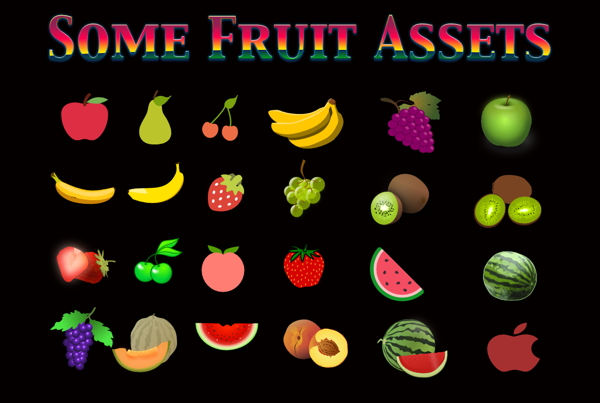Search the Community
Showing results for tags 'Affinity designer'.
Found 5,858 results
-
As I’m coming from Adobe Fireworks I’m sometimes still struggling with muscle memory (or memory in general). In FW it is simple to draw a rectangle marquee over an image, for example, and then copy and paste this selection into a new raster object, or, to drag a marquee, switch to the transform tool, and be able to transform that selection (e. g. stretch a part of the image) right there. How would something like this be done in AD? In AD, I’ve been able to extract part of an image with the workaround of duplicating the image, using the vector crop tool and rasterizing the result. But now, if I resize the object it is adding semi-transparency to the edges; in Fireworks I was also used to being able to resize/stretch such an object while keeping hard edges. What am I missing here? Or am I thinking this from the wrong side?
- 2 replies
-
- designer
- affinity designer
-
(and 1 more)
Tagged with:
-
Create new doc in A10 size on US English macOS. Fill entire document with rectangle filled with other than white. Print document to PDF (preview). PDF document size will be Letter and not A10 as there's an enormous amount of whitespace and tiny rectangle of color..
- 3 replies
-
- affinity designer
- bug
-
(and 1 more)
Tagged with:
-
Hi to all, I am encountering a strange behaviour which might be a bug (or a feature? - I don't know). I have a document in designer which consist of multiple embedded pictures. One picture needed further retouching so I want to open it in Photo. The problems came when I tried to get things back to designer. I tried two different approches 1) In designer I selected the picture and clicked "Edit image" (I don't know the correct english words as I am using the German version). Then I clicked File->Edit in Affinity Photo in the menu. Photo opened up, I did my retouching and saved. A dialog appeared if I wanted to save a reduced version for the desired file format can only contain pixel data -> ok. Then I closed Photo. But the changes did not appear in Designer at all. Bad luck. So I tried a different approach: 2) In designer I selected File->"Edit in Affinity Photo" for the whole document. Photo opens up. There I select the desired picture and select Edit image. Retouching. Save. Reduced format -> ok. Everything's fine. Then I save the whole document and open it again in Designer. But there the picture looks really ugly with huge pixels (like 32 x 24 or so). When I click "edit image" I have the HQ result from Photo but when I close the editing mode, again I have those big blocks. If I try to export a pdf for example - the picture is just not present (in my case there is a coloured square - the container which holds the image in the document). I am not quite sure if this is the correct behavior. But in my opinion at least (2) should have worked properly. So it seams that there is a bug somewhere. Anyway - it would be grad to have a better way to edit an embedded image in photo, like it works in publisher. That's really cool. The workflow to edit an image and then start up the other application while the document in the original application is closed is a bit clumsy imho. Thanks so far. Jan
-
Hi, I created a new document and set the size to 1100 x 1100 pixels (~3.5" x 3.5") and resolution to 300 DPI. I created a few layers and printed the image and it looks great, the size is correct. When I export the *.afdesign file as a PNG and go to print the image it is much larger than 3.5" x 3.5". How do I maintain the same image size and resolution when I export the afdesign to a PNG? Please advise. Thank you, lai1
- 9 replies
-
- affinity designer
- export
-
(and 2 more)
Tagged with:
-
Hi, I'm trying to create a pattern design template. I've designed some objects and added it to the "symbols" library. If I save the affinity designer document and send it to my client, can he/she be able to use my "symbols library with sync enabled" in that document? Or He has to change each and every same objects in that pattern. Please check my attached template file. If you could open this document with the "symbols" library sync enabled, please share me the screenshot. Thank You mypattern_template.afdesign
-
Hello folks, here is a vector portrait of David Bowie, created with Affinity Designer. Would appreciate feedback, that would be great. https://www.bodobe.de/bowie-vector-portrait/
-
I created FlowCharts using Artboards with Affinity Designer, very easy and successful. The text was in English, I saved copies in AF format and as PDF. The PDFs were printed and all the text was, as expected, in perfect English. I have just reopened the file in Affinity Designer to incorporate suggested amendments, and notice that some letters in some words have been replaced with symbols that I don't recognise. The attachment shows the 'new' version of what I typed - and I checked the previously printed copies which confirmed that this change has only occurred on re-opening the file today. The text was entered as: Limited information to branches, e.g. advertising meetings b.... Foreign membership number queries... I checked the language in preferences and it was set to English (United States), I have just reset that to English (United Kingdom and (not surprisingly) the foreign symbols are still in the text. This means I have to check the spelling in 14 artboards/flowcharts, thankfully the red underlining will help. Any ideas why this happened, please? Hilary
- 12 replies
-
Create a text block and put some words in. While still editing that, the Mac defines option-arrows to move the insertion point by words and by extension option-shift-arrows. (Windows ctrl-arrows). It appears you remapped control to command which is incorrect. Command-arrows means move to the end of the line. Option-↑↓ is beginning/end of paragraph respectively though I can't see a lot of use here. I can't fix this using the keyboard control panel and find it extremely aggravating. If I'm at work, my brain thinks Windows. I can't handle 30 years using a Mac and it not working like a Mac. Mildly annoying but not aggravating and it can be fixed using the Keyboard Syspref (or the very Windows one you could have omitted) but is only cosmetic and not worth the effort. Apple decided to show each modifier key to hold so it doesn't show ⌘> for Bigger but shows ⇧⌘. Related... we're used to icons for Portrait/Landscape which required too much thinking to find. Maybe Adobe got "clever" there too (not going to pull up PS Elements to check). There are standardized keys beyond ZXCV such as all Apple apps. Check out the apps that come with a Mac and you'll see a slew for text. (Harkening back to keypads, it doesn't show ⇧⌘= but ⌘+ or at least it does on keyboards with one like mine.) I can understand following Adobe shortcuts and again, can change them so it's not as big of a deal.
- 9 replies
-
- mac
- keyboard shortcuts
-
(and 1 more)
Tagged with:
-
I searched the site and faq without luck. I have an outlined font that I want to fill the whitespace with a gradient. I tried converting the typed text to curves and it appears to have made a single bezier line through the entire glyph (take a C and put a line on the surrounding the inner continuing to the outer edge and then close the C to an O keeping the lines). So, it's treating the text strokes as fill-able but not the whitespace. The attached how do I fill outlineed font with a gradient.pdf shows it well Is there an way without converting to bitmaps (yuck)? Thanks❗️
- 3 replies
-
- affinity designer
- mac
-
(and 2 more)
Tagged with:
-
I’m trying to create a new vector brush using both tapered ends. Not sure how to do this on the iPad. When I try to adjust pressure control the app keeps shutting down. What are the significance of the 4 icons within the stroke panel to the left. Nothing changes when I select each one. thanks
-
-
-
art piece done on Affinity designer ipad pro the most important steps are here if you like it. in this simple guide I hope this can help some of you. I do these tutorials in my free time after work for my clients. anyway is always happy to be sharing my experience. ciao jhon
-
Hi! I read the forums about the fonts from the summer of 2019. I just downloaded 32 fonts and it's only recognizing seven if that. Very disappointing because X9 can see all of them. (X9 the grandfather of affinity) My font folder says I have a total of 523 fonts, less than what the other users had. I was at the most current version and then I kicked back to version 1.6....and it's still not seeing them - very unhappy is there an extension that I can download to fix this problem. Thanks in advance!
- 3 replies
-
- font
- affinity designer
-
(and 1 more)
Tagged with:
-
Hi ! I'm trying to use Affinity Designer to import data from Figma and convert it to an Illustrator file to use in After Effects (yeah, pretty dodgy, but to have each layers, this is almost the only way). Everything is perfect, I get different layers, but the only thing I don't get in Designer is the bitmap data contained inside <image> SVG tags. I joined the sample SVG taken from the demo project in Figma. You can open it in a browser to see the difference. All of these sources are dismissed by Designer. It would be awesome if it could parse it! Profile.svg
-
Is there a way to have text which is on a path, scale like regular text when part of a group? I'll try to explain in detail here: I have a group of objects consisting of 2 text layers, 4 shape layers. One of the text layers is on a path forming an arch over my shape layers. The lower text is just normal text. These are all grouped together as one object. When I scale the group, all the layers, including the bottom text scale proportionately. However the upper text layer (on the path), this text does not scale at all.z Thanks.
- 2 replies
-
- text
- affinity designer
- (and 4 more)
-
I'm not even sure how to word my issue, I've attached videos for visuals. I've Googled to no end and still haven't fixed my problem. I've made sure I changed the resolution on my external monitor which is a Toshiba HDTV. I've changed and played with settings under preferences on my Mac. I've had Affinity Designer for a while now and this just started recently. Nothing has changed. I haven't had any reason to mess with my resolutions since setting up my TV years ago. Even if I adjust the overscan, the AD menus still go off the screen. I only seem to be having issues in Affinity Designer. Does anyone know how to fix or point me in the right direction? Thanks! Screen Recording 2020-01-10 at 2.15.20 PM.mov Untitled.mov Screen Recording 2020-01-10 at 2.15.20 PM.mov
- 6 replies
-
- wrong screen size
- screen resolution
-
(and 3 more)
Tagged with:
-
Cuando los eps tienen diseños complejos de ilustrador, diseño afinidad no te los conserva igual, te los modifica, igual cuando quieres cambiar de ilustrador a afinidad, los textos te los convierten en curvas, el problema con eso, es que si el archivo uno lo quiere modificar, ya no pudiste, tienes que borrar el texto y ponerlo de nuevo, eso no es práctico, deberia tener una opción que te dijera si los textos los quieres borrar en curvas o quieres en letra. Para que no te haga trabajar más. La primera version hecha en ilustrador como se ve esa misma version en AFFINITY
-

affinity designer Folding Scissors - and process video
Jason Ramasami posted a topic in Share your work
Mainly a bit of fun - I recorded a timelapse-with-hints process video making this image. It isn't exhaustive but it gives a structure. http://saamvisual.com/process/2020/1/15/vector-process-folding-scissors Any feedback very much welcome.


















12_57_04.png.156c35e7df762546f7893d3cef66e64c.png)
12_58_25.png.b135cbb47144d1c8802dc903912e1609.png)
